Miguel R. Castellanos
Frequency-selective beamforming and single-shot beam training with dynamic metasurface antennas
Nov 29, 2024Abstract:Dynamic metasurface antennas (DMAs) beamform through low-powered components that enable reconfiguration of each radiating element. Previous research on a single-user multiple-input-single-output (MISO) system with a dynamic metasurface antenna at the transmitter has focused on maximizing the beamforming gain at a fixed operating frequency. The DMA, however, has a frequency-selective response that leads to magnitude degradation for frequencies away from the resonant frequency of each element. This causes reduction in beamforming gain if the DMA only operates at a fixed frequency. We exploit the frequency reconfigurability of the DMA to dynamically optimize both the operating frequency and the element configuration, maximizing the beamforming gain. We leverage this approach to develop a single-shot beam training procedure using a DMA sub-array architecture that estimates the receiver's angular direction with a single OFDM pilot signal. We evaluate the beamforming gain performance of the DMA array using the receiver's angular direction estimate obtained from beam training. Our results show that it is sufficient to use a limited number of resonant frequency states to do both beam training and beamforming instead of using an infinite resolution DMA beamformer.
Towards 6G MIMO: Massive Spatial Multiplexing, Dense Arrays, and Interplay Between Electromagnetics and Processing
Jan 05, 2024Abstract:The increasing demand for wireless data transfer has been the driving force behind the widespread adoption of Massive MIMO (multiple-input multiple-output) technology in 5G. The next-generation MIMO technology is now being developed to cater to the new data traffic and performance expectations generated by new user devices and services in the next decade. The evolution towards "ultra-massive MIMO (UM-MIMO)" is not only about adding more antennas but will also uncover new propagation and hardware phenomena that can only be treated by jointly utilizing insights from the communication, electromagnetic (EM), and circuit theory areas. This article offers a comprehensive overview of the key benefits of the UM-MIMO technology and the associated challenges. It explores massive multiplexing facilitated by radiative near-field effects, characterizes the spatial degrees-of-freedom, and practical channel estimation schemes tailored for massive arrays. Moreover, we provide a tutorial on EM theory and circuit theory, and how it is used to obtain physically consistent antenna and channel models. Subsequently, the article describes different ways to implement massive and dense antenna arrays, and how to co-design antennas with signal processing. The main open research challenges are identified at the end.
Electromagnetic manifold characterization of antenna arrays
Nov 08, 2023Abstract:Antenna behaviors such as mutual coupling, near-field propagation, and polarization cannot be neglected in signal and channel models for wireless communication. We present an electromagnetic-based array manifold that accounts for several complicated behaviors and can model arbitrary antenna configurations. We quantize antennas into a large number of Hertzian dipoles to develop a model for the radiated array field. The resulting abstraction provides a means to predict the electric field for general non-homogeneous array geometries through a linear model that depends on the point source location, the position of each Hertzian dipole, and a set of coefficients obtained from electromagnetic simulation. We then leverage this model to formulate a beamforming gain optimization that can be adapted to account for polarization of the receive field as well as constraints on the radiated power density. Numerical results demonstrate that the proposed method achieves accuracy that is close to that of electromagnetic simulations. By leveraging the developed array manifold for beamforming, systems can achieve higher beamforming gains compared to beamforming with less accurate models.
A generalization of the achievable rate of a MISO system using Bode-Fano wideband matching theory
Oct 15, 2023

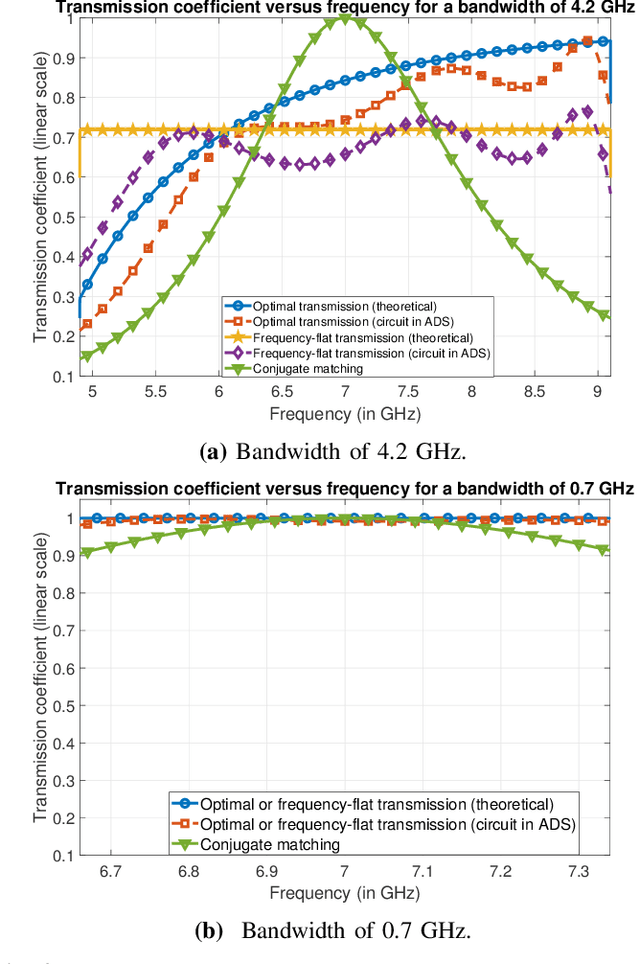
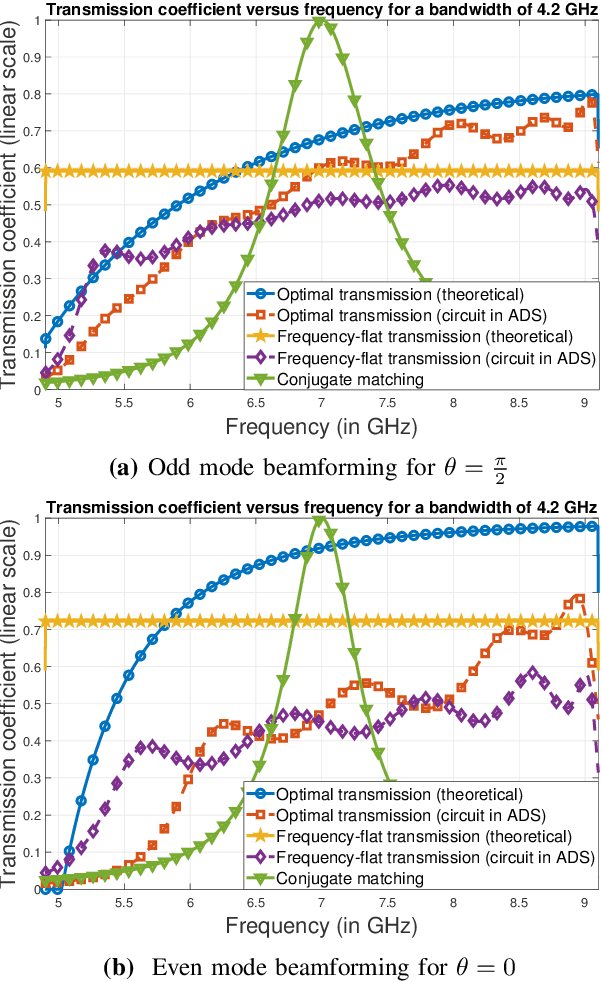
Abstract:Impedance-matching networks affect power transfer from the radio frequency (RF) chains to the antennas. Their design impacts the signal to noise ratio (SNR) and the achievable rate. In this paper, we maximize the information-theoretic achievable rate of a multiple-input-single-output (MISO) system with wideband matching constraints. Using a multiport circuit theory approach with frequency-selective scattering parameters, we propose a general framework for optimizing the MISO achievable rate that incorporates Bode-Fano wideband matching theory. We express the solution to the achievable rate optimization problem in terms of the optimized transmission coefficient and the Lagrangian parameters corresponding to the Bode-Fano inequality constraints. We apply this framework to a single electric Chu's antenna and an array of two electric Chu's antennas. We compare the optimized achievable rate obtained numerically with other benchmarks like the ideal achievable rate computed by disregarding matching constraints and the achievable rate obtained by using sub-optimal matching strategies like conjugate matching and frequency-flat transmission. We also propose a practical methodology to approximate the achievable rate bound by using the optimal transmission coefficient to derive a physically realizable matching network through the ADS software.
Joint Band Assignment and Beam Management using Hierarchical Reinforcement Learning for Multi-Band Communication
Aug 25, 2023



Abstract:Multi-band operation in wireless networks can improve data rates by leveraging the benefits of propagation in different frequency ranges. Distinctive beam management procedures in different bands complicate band assignment because they require considering not only the channel quality but also the associated beam management overhead. Reinforcement learning (RL) is a promising approach for multi-band operation as it enables the system to learn and adjust its behavior through environmental feedback. In this paper, we formulate a sequential decision problem to jointly perform band assignment and beam management. We propose a method based on hierarchical RL (HRL) to handle the complexity of the problem by separating the policies for band selection and beam management. We evaluate the proposed HRL-based algorithm on a realistic channel generated based on ray-tracing simulators. Our results show that the proposed approach outperforms traditional RL approaches in terms of reduced beam training overhead and increased data rates under a realistic vehicular channel.
Hierarchical Codebook Design with Dynamic Metasurface Antennas for Energy-Efficient Arrays
May 15, 2023Abstract:Dynamic metasurface antennas (DMA) provide a solution to form compact, cost-effective, energy-efficient multiple-input-multiple output (MIMO) arrays. In this paper, we implement a practical hierarchical codebook with a realistic DMA design through electromagnetic simulations. We leverage existing DMA models to derive a novel method for enhancing the beamforming gain. We find that the proposed method provides better coverage and spectral efficiency results than prior methods. We also present and verify a new technique for creating wide beamwidths through the DMA and hierarchical codebook. Additionally, we use a detailed transmitter architecture model to determine the power consumption savings of the DMA compared to a typical phased array. The DMA largely outperforms a passive phased array in terms of spectral and energy efficiency due to high component loss from a high-resolution passive phase shifter. While the DMA provides lower spectral efficiency results than the active phased array, the DMA achieves a higher energy efficiency because of the significant power consumption for the active phase shifters. Therefore, we find that DMAs in a realistic wireless environment provide sufficient coverage and spectral efficiency compared to typical phased arrays while maintaining a substantially lower power consumption.
Joint Relay Selection and Beam Management Based on Deep Reinforcement Learning for Millimeter Wave Vehicular Communication
Dec 19, 2022Abstract:Cooperative relays improve reliability and coverage in wireless networks by providing multiple paths for data transmission. Relaying will play an essential role in vehicular networks at higher frequency bands, where mobility and frequent signal blockages cause link outages. To ensure connectivity in a relay-aided vehicular network, the relay selection policy should be designed to efficiently find unblocked relays. Inspired by recent advances in beam management in mobile millimeter wave (mmWave) networks, this paper address the question: how can the best relay be selected with minimal overhead from beam management? In this regard, we formulate a sequential decision problem to jointly optimize relay selection and beam management. We propose a joint relay selection and beam management policy based on deep reinforcement learning (DRL) using the Markov property of beam indices and beam measurements. The proposed DRL-based algorithm learns time-varying thresholds that adapt to the dynamic channel conditions and traffic patterns. Numerical experiments demonstrate that the proposed algorithm outperforms baselines without prior channel knowledge. Moreover, the DRL-based algorithm can maintain high spectral efficiency under fast-varying channels.
A wideband generalization of the near-field region for extremely large phased-arrays
Jun 30, 2022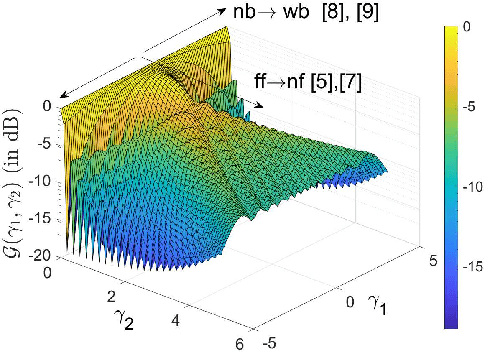
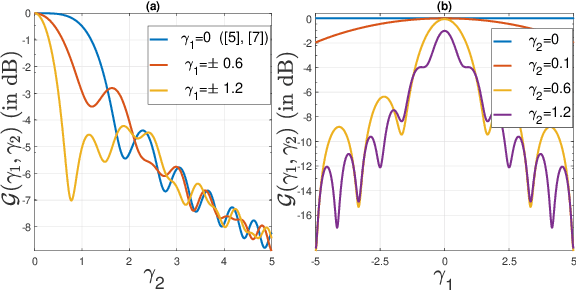
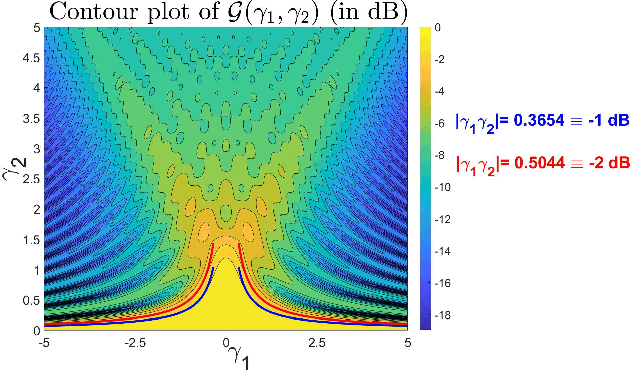
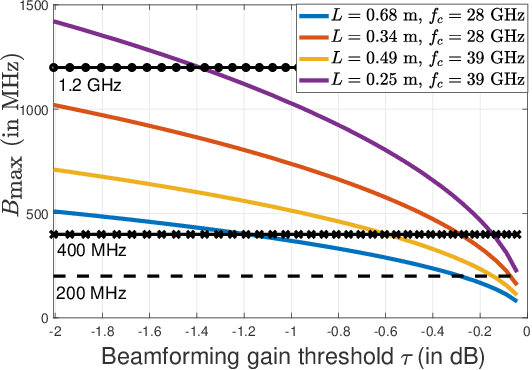
Abstract:The narrowband and far-field assumption in conventional wireless system design leads to a mismatch with the optimal beamforming required for wideband and near-field systems. This discrepancy is exacerbated for larger apertures and bandwidths. To characterize the behavior of near-field and wideband systems, we derive the beamforming gain expression achieved by a frequency-flat phased array designed for plane-wave propagation. To determine the far-field to near-field boundary for a wideband system, we propose a frequency-selective distance metric. The proposed far-field threshold increases for frequencies away from the center frequency. The analysis results in a fundamental upper bound on the product of the array aperture and the system bandwidth. We present numerical results to illustrate how the gain threshold affects the maximum usable bandwidth for the n260 and n261 5G NR bands.
 Add to Chrome
Add to Chrome Add to Firefox
Add to Firefox Add to Edge
Add to Edge